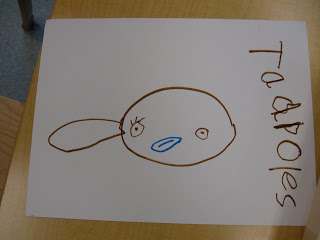What a busy week!
We are currently studying life cycles, paying particular attention to animals that go through metamorphosis. We have been able to watch our Painted Lady Butterflies transform from larvae to butterflies. On Friday we were pleasantly surprised to find that our Polythemus Moths, who recently emerged from their cocoons have laid eggs! We are looking forward to seeing the whole life cycle of the moth, from egg to adult. This week we completed our Butterfly Life Cycle books, finishing with the book covers. We are now scientific authors and experts on the stages a butterfly goes through.



This week we started studying the life cycle of frogs. We were fortunate enough to get indigenous Pacific Tree Frog (aka Pacific Chorus Frog) eggs (thank you Justin's mom!) for our classroom. Over the past week, tiny tadpoles have hatched out of the eggs. Being scientists, we are writing and drawing our observations, which will help us keep track of the physical changes that will occur during the life cycle of the frogs.


We took advantage of the nice weather this week to begin our gardening unit, which will continue through the rest of the school year. To begin, we worked together to haul rich healthy soil to a new planter which will become our flower garden. We also planted two variety of peas and thinned the leaks that had wintered over. Our gardening unit will give us an opportunity to experience the life cycle of plants, in addition to many other interesting and enriching activities.




We helped Bethany celebrate her 5th Birthday!!! Happy Birthday Bethany!

If you visit the Children's Fair this Saturday, check out the beautiful butterflies the students made for the ELC banner!

One of our Polythemus Moths:


















































